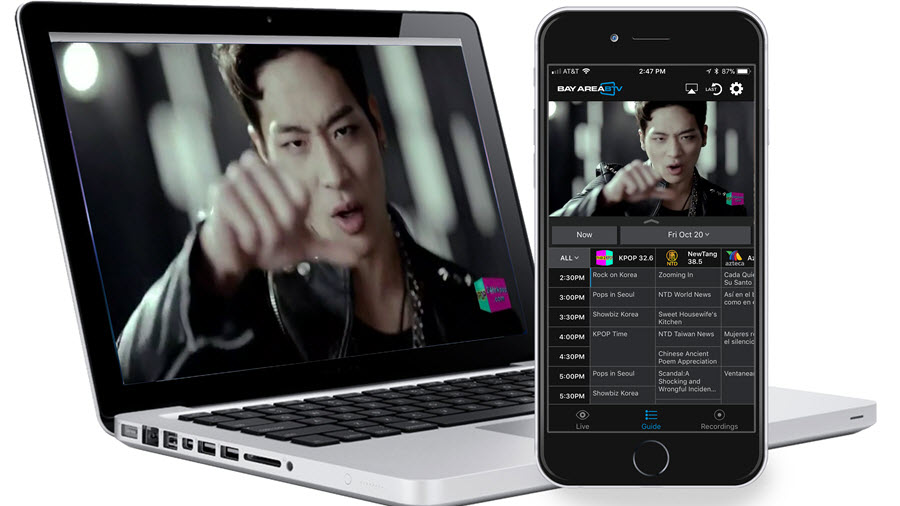Didja Takes Dozens of TV Stations Over-the-Top in San Francisco DMA

Following an earlier trial in Phoenix, Didja has teamed with a group of broadcast TV stations in the San Francisco Bay Area to deliver live, local signals over-the-top to web browsers and mobile devices alongside with an optional DVR service.
Didja’s LocalBTV offering, branded as BayAreaBTV in the local area, is a free app that also supports an optional cloud DVR service that costs $4.95 per month for 1 terabyte of storage (under the default setting, recordings will auto-expire after 28 days, but users have the option to keep individual recordings longer).
BayAreaBTV is initially supported on web browsers and apps for iOS and Android smartphones and tablets. The service is also accessible via Chromecast streaming adapters and Apple TV boxes (via AirPlay). Didja plans to extend support to other TV-connected platforms.
Didja believes that the offering will be particularly appealing to millennials and other younger audiences that like to watch TV on mobile screens, as well as bilingual households in the region.
On a more general basis, Didja is trying to capture cord-cutters who have fallen out of the pay TV ecosystem, as well as consumers who have never taken a traditional pay TV service. It also views itself as a service that could complement a growing crop of virtual MVPDs such as YouTube TV, while also giving local broadcasters another, easily accessible distribution outlet in their local markets.
BayAreaBTV is launching with a lineup of more than 35 channels that include a mix of non-English speaking channels offered in the area, some local English-language stations, as well as a batch of national “diginets.”
A representative list of channels available via the service in the Bay Area includes TV Azteca (Spanish), Skylink and U Channel (Chinese), DiyaTV (South Asian), Viet Bay and Net V (Vietnamese), KPOP (South Korean music videos), Blues Television Network, Bounce, GetTV, and Escape.
BayAreaBTV as well as the Phoenix-area version – a service called PhoenixBTV that has a lineup of about 25 channels -- currently do not deliver live local feeds from major broadcasters such as ABC, NBC, Fox and CBS, though the company’s intention is to add them to its local OTT lineups, eventually, according to Jim Long, Didja’s CEO.
Long said the aim is to offer a lineup of between 60 to 70 channels at some point. Didja likewise plans to expand coverage to 40 metro areas in the U.S., with Los Angeles being its next target market.
Unlike the model that the now-defunct Aereo used for a short-lived OTT TV service that attempted to deliver local broadcast TV feeds without carriage agreements, Didja’s service carries only the broadcast networks via its OTT service that have offered consent, and access to those lineups are limited to the consumers if they are currently in the local area.
For example, Didja estimates that BayAreaBTV is available to about 2.6 million households in an eleven-county that covers Santa Clara County to the south, Mendocino County to the north, Contra Costa County to the east, and every geographic area in between.
Didja’s platform, currently limited to its first two DMAs, captures over-the-air TV feeds from partner programmers at a local data center, where that feed is then prepared for streaming to supported devices in the local region.
BayAreaBTV and its OTT distribution model is appealing to KPOP in part because a portion of its audience doesn’t have a TV or an antenna to receive the signal.
“But they always have their phone, and they are always on their phone,” Kelly Quan, KPOP’s CEO, said in an interview, estimating that about 70% of KPOP’s audience consists of English-only speakers.
Quan also believes the service will also deliver new audiences to KPOP. “I see this as a perfect time for this kind of app,” he said.
“The launch of LocalBTV is a great avenue for independent content creators and networks to expand their reach and engage new audiences. It also addresses an audience that is loyal consumer of broadcast stations that are over the air but can’t watch their favorite programming on the go via mobile,” Eric Ratchman, EVP of content distribution for Univision, said in a statement.
Broadcasting & Cable Newsletter
The smarter way to stay on top of broadcasting and cable industry. Sign up below










